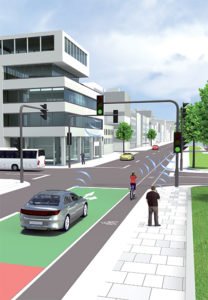 Yashesh Jain
Yashesh Jain
VP-Strategic Marketing & Sales,
Power Electronics
Power electronics as a company has always been in the forefront introducing innovative solutions for the Indian market in association with market leaders in their respective segments.
In continuation to the same the company has entered into a strategic agreement with Gevas Software for providing ATCS solution for the upcoming smart city projects for the Indian market.
ACTS means that the traffic control entities (traffic controllers and central systems) are taking information available into account and adept the steering of traffic for a better result. Gevas started 30 years ago with adaptive steering using information from detectors attached to the traffic controllers. Later, we used the same information but using it in software components of the traffic central. It has been 10 years we started to create the Advanced Traffic Management (ATM) solution VTmanager. This enhances the way of how flexible and rich the concept of adaptivity can be used.
• All information (traffic info from highways, level of service, floating car data, environmental data, parking info, Car2X, weather info, flood info, gas detection, crime sounds, and so much more …) which could be relevant for traffic (and technically available) can be taken into account.
All information (traffic info from highways, level of service, floating car data, environmental data, parking info, Car2X, weather info, flood info, gas detection, crime sounds, and so much more …) which could be relevant for traffic (and technically available) can be taken into account.
• This available info can be proceeded into knowledge by using functions (mathematical, statistical, Boolean, …). The current language of functions can be extended by new functions needed for new installation / customers using the existing plug-in mechanism.
• Having the knowledge all accessible actions (changing behavior of traffic controller, content on Variable Message Signs VMS, gates, rising pols, content in GIS web portal, information for national traffic data centers or brokers, Car2X, messages on social medias like Twitter, and so much more) can be triggered – if wanted even without interaction of a user.
We store all relevant input data in a generic database. We have projects where we store and use more than 100.000.0000 data records a day.
Using our solution, Event Manager, we proactively share the info ( sport or concert events in an arena VIP protocol routes..) with all relevant receivers like traffic operators in the center, informed drivers via apps on their mobiles, web portal or social media or even traffic steering components in the traffic management center. For the purpose of mathematical optimization we can integrate network aspect and local intersection aspect seamlessly into our ATCS solution.
There will be traffic situations where an experienced traffic engineer wants to have a special solution for performance or traffic safety reasons. In this case we are providing the full flexible traffic logic language openTRELAN which runs within TRENDS-Kernel (TK) as an library in the firmware of the traffic controller itself. This enables the city authorities (if needed or to be intended) to be independent from machine decisions for safety reasons. This will be supplied in the Traffic Engineering workstation CROSSIG which exists more than 35 years now (over 300 customers in 30 countries).
Everybody around the world is talking about smart cities these days. Most of the active and upcoming tenders are connected to the bigger picture of smart cities. When the ATCS as part of the ATM is connected to all the infrastructure of smart cities, it benefits both connection, to all inputs available and all devices & actions which can be triggered. It starts from emptying street for emergency vehicles, goes via prioritising the public transport to locking down streets because of detected gas leak for safety reasons and ends up with all the promising services which are now researched and developed regarding cooperative ITS and even autonomous vehicles.
All smart systems need to have access to input data like detectors. But when you want to have a smarter system you need to have more knowledge and more information.
A lot of companies tend to “protect” their claims while not providing open interfaces. These market entry barriers are practically used to keep new ideas out and guarantee defacto oligopoly or even monopoly prices.
 TrafficInfraTech Magazine Linking People Places & Progress
TrafficInfraTech Magazine Linking People Places & Progress